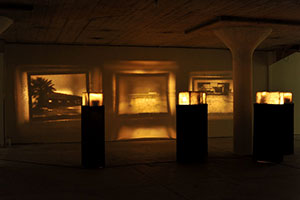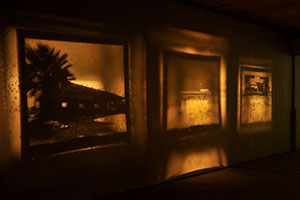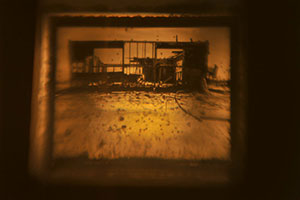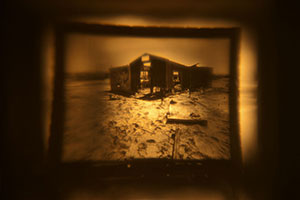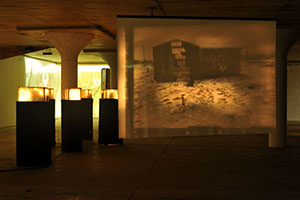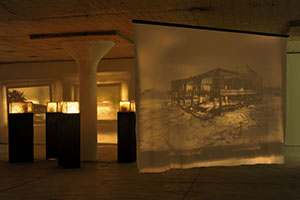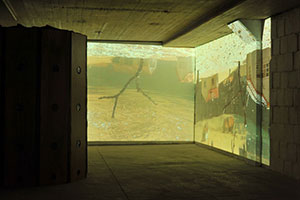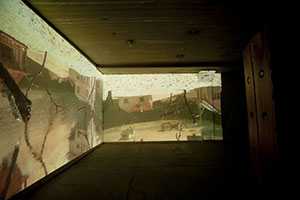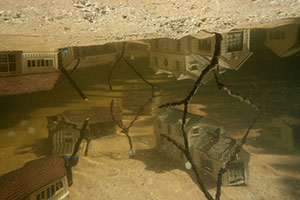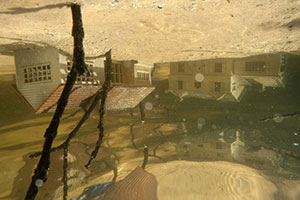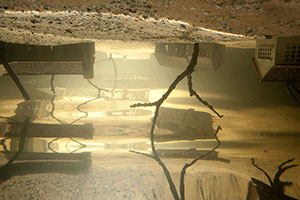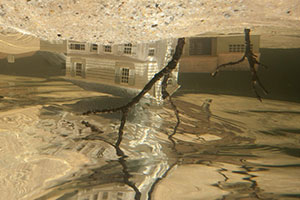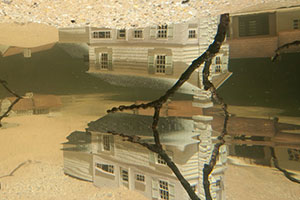
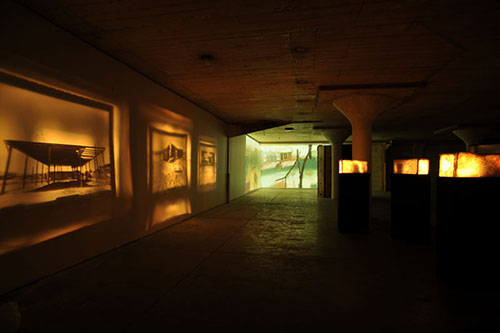 not me, and probably not you (installation view), 2010 not me, and probably not you: Crucible Projectors (installation view video), 2010 not me, and probably not you: Floodtown, 2010 Press: Beyond Western New York Art in Ameria, December 2010 By Faye Hirsch Art offerings reach beyond 'Beyond/In' The Buffalo News, October 10, 2010 By Colin Dabkowski Art Scene Projections Artvoice, October 6, 2010 by Jack Foran |
not me, and probably not you:
Beyond/In WNY Biennial When an image is created photographically, there is a confluence of the subject, place, event, and the photographic device and image maker. Lines intersect at a single point that is the image, then continue on each on their own trajectory. There is a famous photograph, titled "Migrant Mother", taken by Dorothea Lange for the FSA during the Great Depression of the 1930s that even today is very well known. One of thousands of photographs taken by Lange and the other FSA photographers, this photograph was chosen to be "the" image the plight of the farmers, representing the economic disaster of the great depression and the environmental disaster of the dust bowl. Although Thompson's names wouldn't be connected with the subjects of the photograph for another four decades, this brief meeting with Lange while stranded on the side of the road resulted in an image that cannot be separated from the disaster and the resulting human conditions for what will likely be hundreds of years. This is the nature of the recorded image, just as it is the nature of history to repeat itself. The installation for Beyond/In involves a series of hand-built slide projects, two video projections, and a wall of camera obscuras. The five projectors in the installation are sewn together with a white, high-temperature insulation normally used to build kilns. Inside each projector is a 500 watt halogen lamp and a glass tank filled with water. Suspended in the water is a sheet of film. As the heat from the halogen bulb brings the water in the tank to a boil, the image being projected is comprised of both the content of the film and it's destruction. The images on the film inside the projectors were shot at the abandoned resort town on the banks of the Salton Sea in southern California. The Salton Sea was the result of the disastrous breach of the Colorado River at the turn of the last century, when the river flooded and breached the Imperial Valley Dike and filled the low-lying basin where the sea is now. Only a few hours from Los Angeles this accidental sea was later seen as the perfect place to build a resort community to rival Las Vegas. Unfortunately, as the salinity continued to rise and sewage and agricultural run-off flowed in the sea began to die. For the past few decades it has been a foul smelling place of dead fish and bacteria, and the resort has long been abandoned to decay.
As the Salton Sea itself is the product of of a series of disasters, the projections are small disasters happening in the presence of the viewer. A hundred different images of the Salton Sea will be projected and destroyed as the sheets of film are boiled and replaced during the course of the exhibition.
Beyond the crucible-like projectors are a pair of floor-to-ceiling video projections and a large circular wall of camera obscuras. Video of a small town shot upside down underwater, submerged in a flood, is a constructed reality. The town references the recorded images of floods, filmed and photographed a hundred years ago or in the very recent past. There is a continuity in disasters as images of floods in Pakistan, New Orleans, Galveston, or Johnstown may be sometimes indistinguishable from one another. Standing between the video projections and the camera obscura the viewer watches the imagery from the perspective of themselves being upside down and underwater, as if caught in the flood. All optics cast an image that is upside down, so from the within the camera obscura the image is reversed again. The video imagery is right side-up and the viewers watching from outside of the camera are upside down. The floor to ceiling video imagery is meant to be perceived at a larger scale as if the viewer were there. But the video is really a backdrop that places the viewer of it within an environment meant to be seen with in the camera obscura. As with the boiling projectors, the event being witnessed is not the images captured in the past but those being created in the present. |


